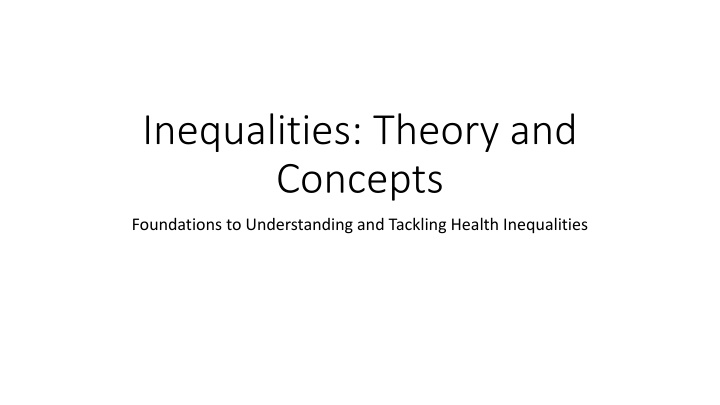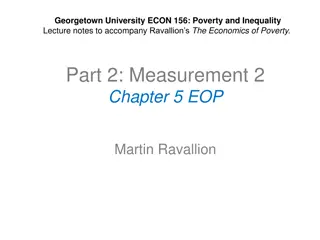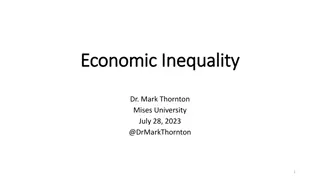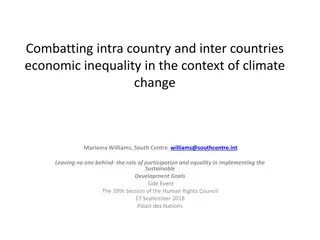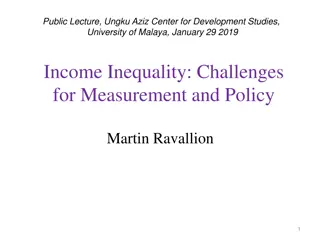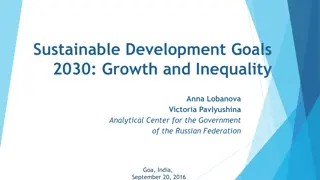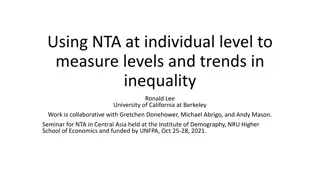Foundations of Health Inequality
The theory and concepts behind health inequalities, discussing topics such as poverty, social determinants, gender, race, and emerging issues. Delve into readings by experts in the field and understand crucial keywords related to tackling health inequities for sustainable development.
Download Presentation

Please find below an Image/Link to download the presentation.
The content on the website is provided AS IS for your information and personal use only. It may not be sold, licensed, or shared on other websites without obtaining consent from the author.If you encounter any issues during the download, it is possible that the publisher has removed the file from their server.
You are allowed to download the files provided on this website for personal or commercial use, subject to the condition that they are used lawfully. All files are the property of their respective owners.
The content on the website is provided AS IS for your information and personal use only. It may not be sold, licensed, or shared on other websites without obtaining consent from the author.
E N D
Presentation Transcript
Inequalities: Theory and Concepts Foundations to Understanding and Tackling Health Inequalities
Introduction 17hSept FOUNDATIONS TO UNDERSTANDING AND TACKLING HEALTH INEQUALITIES An Introduction to Concepts and Theory of Inequality, Equity and Justice Poverty within and Between Countries and Health Inequalities Systems, Resources and Access to Health Introductions PART I Seminar 1 24thSept Seminar 2 1stOct Student Case Studies Seminar 3 8thOct Seminar 4 15hOct Student Case Studies Social Determinants Approach to Health Student Case Studies UNDERSTANDING AXES OF HEALTH INEQUALITIES Gender (ONLINE CLASS) Race and Ethnicity PART II Seminar5 22ndOct Seminar 6 29 Oct 5thNov Student Case Studies READING WEEK Place Seminar 7 12thNov Seminar 8 19thNov Seminar 9 26thNov Student Case Studies Education, Work and Living Student Case Studies Immigration, Migration and Movement of People Student Case Studies EMERGENT ISSUES IN HEALTH INEQUALITY Climate and Environment PART III Seminar 10 3rdDec Seminar 11 10th Dec Seminar 12 17th Dec Student Case Studies Technologies Student Case Studies New issues: Geopolitics to Trade
Readings Braveman, P., & Gruskin, S. (2003). Defining equity in health. Journal of Epidemiology & Community Health, 57(4), 254-258. Hofrichter, R (2010) Part I, Chapter 1, Tackling Health Inequities: A Framework for Public Health practice (pp3- 43). Jamison, D. T., Summers, L. H., Alleyne, G., Arrow, K. J., Berkley, S., Binagwaho, A., ... & Yamey, G. (2013). Global health 2035: a world converging within a generation. The lancet, 382(9908), 1898-1955. McCartney, Gerry, et al. "Defining health and health inequalities." Public health 172 (2019): 22- 30. McCartney, G., Collins, C., & Mackenzie, M. (2013). What (or who) causes health inequalities: Theories, evidence and implications? Health Policy, 113(3), 221-227. Sen, A., Anand, S., & Peter, F. (2004). Why health equity?.In Tackling Health Inequalities Through Public Health: Theory to Action, (2010 edition) Hofrichter, R. , Bhatia, R. (Eds.) OUP
Keywords/jargon in SDG GH Approach Reduce Social Inequities for Sustainable Development : Leave no one behind Tackle Health Inequities to Achieve Health for All Measuring and Monitoring Inequalities Crucial to identify Differences in Health between Population Subgroups Data provides evidence for policies, programmes and practices
Definitions and Descriptions of Concepts: Brainstorm examples Health and/or Social Inequality Health Equality Health Inequity Health Equity Health and Social Justice Health and Social Injustice Others Of Health Are they binary? From where do these emerge? Epistemology? Context? What values underpin them? How do they interrelate?
How practical are these concepts? Could they inform research? Could they guide interventions Could they shape policy? Are they measurable? How? With what data from where? Whose responsibility are these concepts?
Why we need definitions and concepts ? Shared understanding Good to think with Sometimes good with act with Point of departure Know your object of study Unit of analysis What data to collect to make it visible Often changing
Key Thinking & Frameworks 19th 20thCentury individual science & pathologies Biomedical Social Kimberl Crenshaw in the context of feminist theory Intersectionality Theory Determinants of health (SDH) Black Report in 1980, WHO's "Closing the Gap 2005 report Michael Marmot Frameworks to think with Capabilities Approach Sen health economics EcosocialTheory Nancy Krieger Fundamental Cause Theory (FCT) Bruce Link and Jo Phelan (1995)
Dig down on Sen capabilities approach Capabilities Freedoms and Functioning's (rather than resources and outcomes) Equity should expand capabilities not just equalize health outcomes Structural inequalities but ignores context and ind lives and their disadvantages Must address broader soc-eco justice But contrasts with - Utilitarian approach - At odds with free-market (he sees the role of state) - Less about basic needs i.e. food, water, shelter - Challenges biomedical model- adds social, economic and environmental
Dig down on Braveman versus McCartney Health Equity and avoidable inequalities which are socially produced Demands policy interventions Need to address social determinants Less focus on defining health, more on processes and conditions that enable health equity Very ethics and justice focused Health Inequalities focus stress systematic differences More technical approach to defintions Health as a state of enabling participation in society functional and structual Very policy and research focused
Relevant Readings Recommended Readings: Marmot, M. (2010). Fair Society, Healthy Lives: The Marmot Review. Link, B. G., & Phelan, J. (1995). "Social Conditions as Fundamental Causes of Disease." Journal of Health and Social Behavior. Krieger, N. (2001). "Theories for Social Epidemiology in the 21st Century: An Ecosocial Perspective." International Journal of Epidemiology. Solar, O., & Irwin, A. (2010). A Conceptual Framework for Action on the Social Determinants of Health. World Health Organization.
Questions Do different frameworks complements each other in understanding health inequalities? Are there health issues where one framework is more appropriate than another? How would different frameworks inform public health interventions for a specific inequality (e.g. racial disparities in maternal mortality?)
Values and Principles of equity Human Rights Approach Justice and Fairness Approach (John Rawl- focus on primary goods rather than freedoms & capabilities) Capabilities plus Gender Approach Martha Nussbaum similar to Sen in that GH should focus on expanding freedoms and opportunities PHC Alma Ata 1978, Astana 2018 (signed 2019)
Role of frameworks in policy and research Policy Implications: Frameworks like SDH and FCT have been used to shape public health policies targeting inequality. For example, the World Health Organization s approach to health equity is grounded in the SDH framework. Research Implications: The choice of framework influences research design, including the types of questions asked, the populations studied, and the interventions tested. Example: A study using the intersectionality framework might investigate how health disparities manifest at the intersection of race, gender, and class, while a study using the SDH framework might focus more broadly on environmental factors.
Can health equity be universalised to GH? 1.Moral and Ethical Responsibility: health is a fundamental human right. Achieving universal health equity is seen as a moral imperative to eliminate preventable health disparities. 2. Global Economic Benefits: Improving health equity globally can foster economic growth. Healthy populations are more productive therefore increased economic activity, reduced poverty etc. 1. Resource Limitations: Uneven distribution of resources 2. Political and Economic Barriers 3. Improved Public Health Outcomes Addressing health disparities can reduce the burden of disease, reduces the spread of epidemics, improves global health security. 3. Global Power Imbalances: Structural power imbalances- Income, GDP, Trade, Resources, Knowledge transfer .
WHO Health Inequality Monitor Disaggregated data challenge Health equity is the absence of unfair, avoidable or remediable differences in health among population groups, defined by social, economic, demographic or geographic characteristics. Health inequalities are measurable differences in health across population subgroups. https://www.who.int/data/inequality- monitor#:~:text=Health%20inequalities%20are%20measurable%20differences,gaps%20and%20achieve%20health%20 equity.
